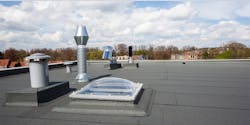Crucial Winter Roof Maintenance
Let’s be honest, the roof on your building didn’t have a spring inspection this year, right? Was it inspected last year? Has it been inspected since it’s been installed? Suffice it to say the roofing industry’s recommendation for twice-yearly roof inspections is not readily followed. Now is a good time – before winter arrives – to have your roof serviced.
It’s likely you drove your car to work today, or at least to the train station if you’re a commuter. I bet you follow the required maintenance schedule – oil changes, system checks, tire rotation – pretty religiously. So why aren’t you maintaining your roof religiously? You roof was almost certainly much much more expensive than your car! And if your roof “breaks down,” what is the potential loss to your building, your business, and/or your tenant/rental income? Just like maintaining your car, regular roof maintenance can find and repair small problems before they become really big problems, and it can maximize the roof’s service life.
While the ideal time to start a maintenance program is immediately after installation, one can be started at any time. Regular roof maintenance has two prongs: those items that can and should be done by the building owner or facility manager and those items that should be done by a professional roofing contractor.
Owners should:
- Keep a roofing file. The file should include documents from the original installation, such as plans and specs, invoices, the installing contractor’s contact information, warranties, maintenance and inspection reports, repair bills, and samples of products that were installed. This information can be extremely helpful when repairs are made or new equipment is added to a roof, especially one that is under warranty.
- Ensure at least one yearly inspection is performed. Ideally, two should be performed: one in the spring and one in the fall. Inspections should also be performed after severe weather events. After a hail storm and after a storm where debris flew around, at least have the maintenance staff take a look at the roof for damage.
- Keep debris from accumulating on your roof. Leaves and branches can block drains and scuppers creating ponds and adding unnecessary weight to the rooftop. Other trades may leave discarded materials which can abrade the surface and puncture the membrane. A roof is not a storage location and should always be kept clear of unnecessary items.
- Maintain rooftop equipment. Often leaks from rooftop equipment are deemed to be roofing problems. New rooftop equipment should always follow the roof manufacturer's guidelines and most often should include a roofing contractor to ensure all penetrations are flashed properly. Also, ensuring HVAC maintenance workers (as well as other trades) do not damage a roof during maintenance is critical. HVAC panels have sharp corners that can puncture a membrane. Proper rooftop protection should be required.
- Ensure exhaust from vent stacks is handled properly. If contaminants in exhaust end up on the roof surface, they should be properly managed with catchment systems or sacrificial membranes, ensuring the primary membrane remains intact and functional. Condensate from HVAC equipment should be piped directly to drains and not allowed to flow across the roof surface.
- Minimize rooftop traffic, and use traffic pads in heavily trafficked areas and around rooftop equipment. Keep a log of workers who access the roof, and keep access doors and roof hatches locked at all times to prevent unwanted access.
- Ensure that only manufacturer certified roofing contractors are allowed to inspect, maintain and repair your roof. Many manufacturers have some type of a certified maintenance program.
- Recognize that your roof warranty requires regular maintenance.
During routine maintenance inspections, contractors should:
- Methodically inspect the field of the roof, penetrations, and the perimeter to ensure no part of the roof is missed. Check for seam problems, such as fishmouths and missing sealant, as well as surface degradation and punctures. Check metal flashings and counterflashings for issues such as corrosion, missing fasteners, looseness and damaged laps. Soft spots in the field of the roof may be an indication of wet insulation and some type of moisture issue. Penetrations and perimeter edges are the most common locations for water entry.
- Inspect adjacent surfaces, such as parapet walls, penthouses and facades. Damaged or deteriorated materials, missing sealant, worn out mortar joints and missing window gaskets can all be leak locations that may be incorrectly assumed to be a roofing problem.
- Talk with the building’s personnel to find out if there are any current leaks or problems with the roof system.
- Make any necessary repairs properly, following manufacturer’s repair and installation instructions and using manufacturer’s recommended products. File required paperwork with the manufacturer to ensure the warranty is protected. Importantly, maintenance and repair contractors should be authorized by the manufacturer of the roof system.
As an owner, it is important to establish a regular roof maintenance program to ensure the asset that protects all other assets functions properly. A maintenance program helps reduce the risk of unexpected and costly roofing-related expenses by providing the expertise to both maintain and service the roof if repairs are necessary.
James R. Kirby, AIA, is the Building and Roofing Science Architect for GAF serving the east coast.
